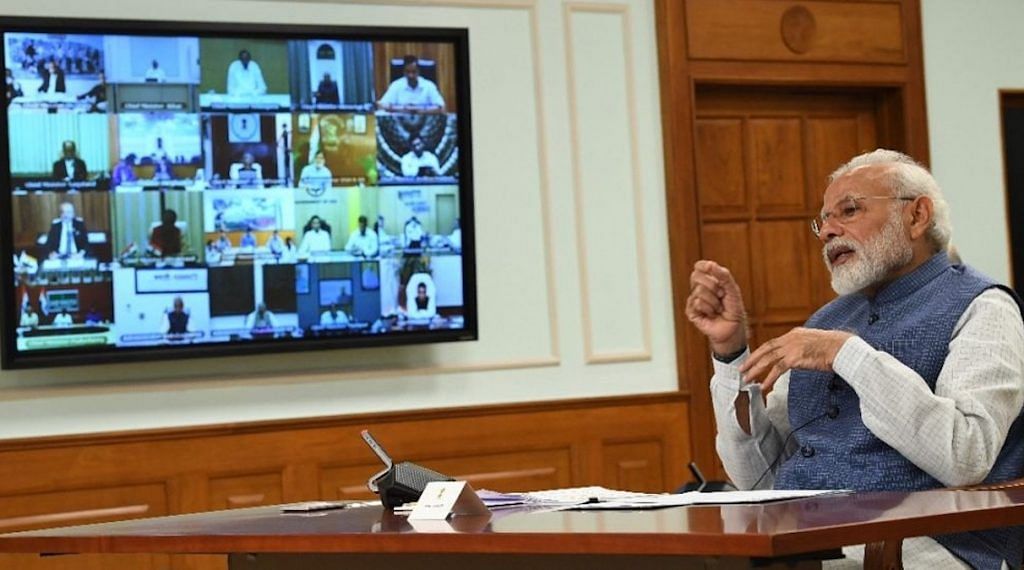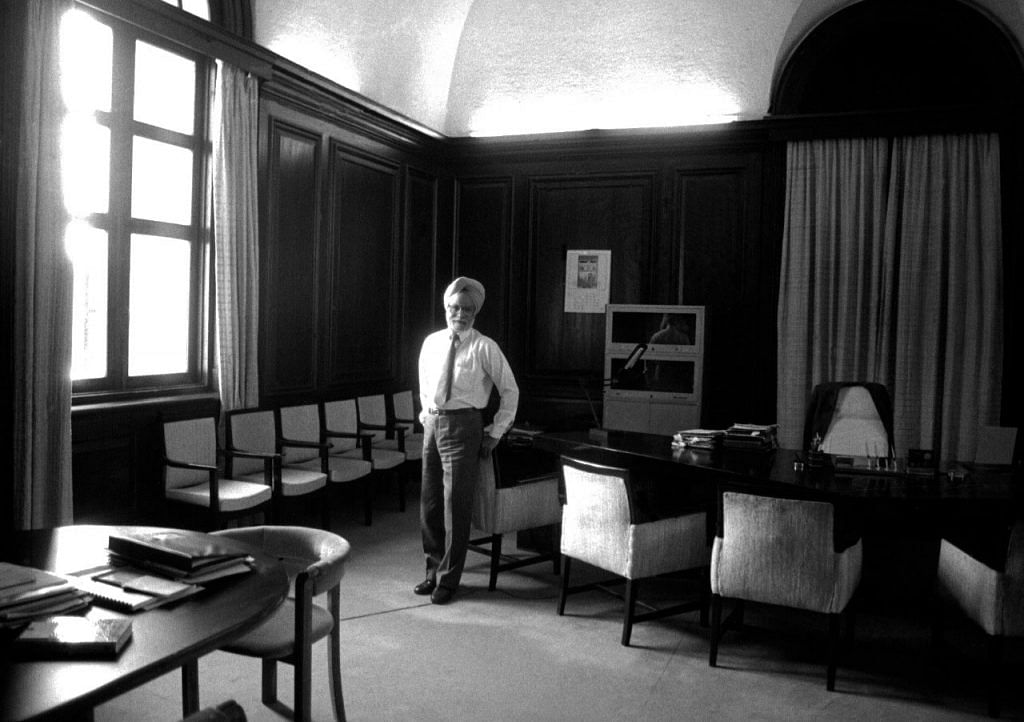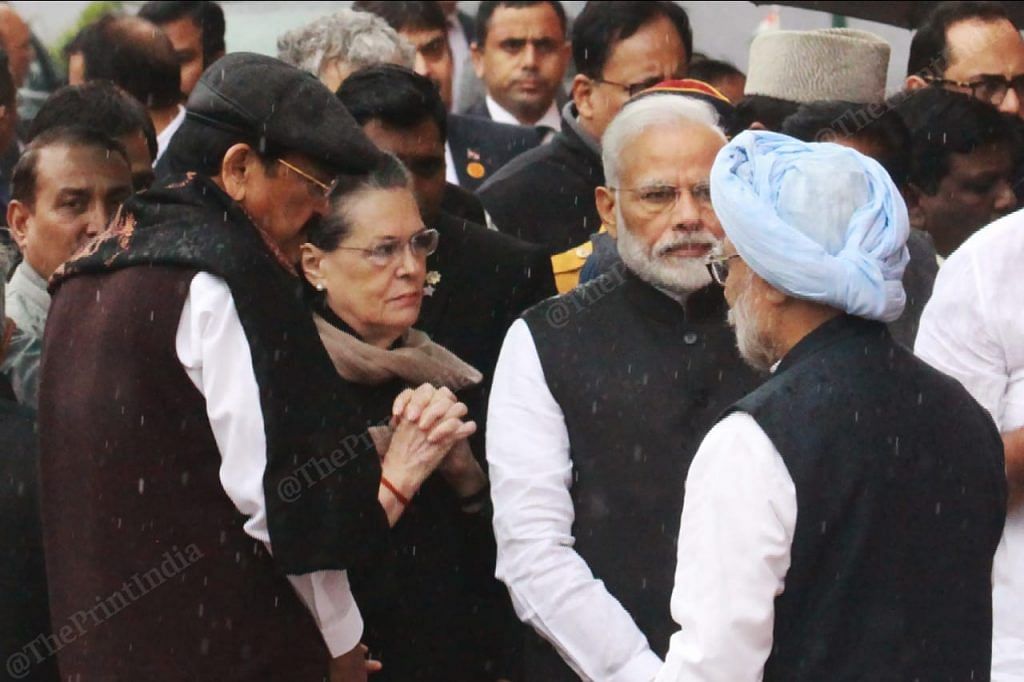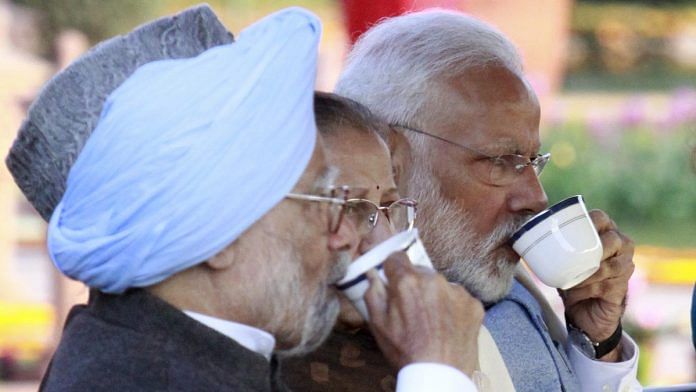It is a tantalising thought to entertain. Prime Minister Narendra Modi’s charisma and oratory are just what Indians need to obey lockdown orders and other candles and claps requests during the coronavirus pandemic. None of this would have been this easy if Manmohan Singh was the prime minister today and presiding over the Covid-19 crisis.
Singh’s wispy voice, meek demeanour and complete lack of either political capital or fan-following across India would have been huge hurdles in pandemic leadership. Imagine the 8 pm address by him telling people to stay indoors. Not just citizens, but even his own cabinet colleagues would not have spoken in one voice.
But India is different under Narendra Modi. Those in direct touch with health and family welfare Secretary Preeti Sudan say even if they send her a query on the coronavirus pandemic at 2 am on WhatsApp, they have a clear answer within minutes. Quite a change from the Union health minister under Manmohan Singh’s second UPA government — Ghulam Nabi Azad who abhorred using the mobile phone even for routine calls.
That’s far from the only difference between the two governments, one run by Manmohan Singh between 2004 and 2014, reflecting his personality, and the fact that he was only one among others who had a say; and the other run by Prime Minister Narendra Modi, whose voice is the only one that matters. Manmohan Singh was supportive, while Modi is assertive.
But leadership is more than just impressive personality traits and cult following. Democracy is all about the work of building institutions and the people who run it – away from the cameras, headlines and hashtags.
And Singh was a quiet power—driven by institutions and systems, Modi is visible and vocal, powered by his own personality.
Also read: Poke fun at taali, thaali, diya and mombatti all you want. Modi couldn’t care less
Kinder history
Although the scale of the epidemic was not as widespread, but when the H1N1 virus struck India in 2009, claiming over 1,800 lives and infecting 20,000, Ghulam Nabi Azad was the face of the government, speaking to each chief minister to mobilise political attention, recalls former Union health secretary K. Sujatha Rao, with additional face-to-face meetings with state health ministers. Quite a change from this time when the daily briefing on coronavirus is not taken by health minister Harsh Vardhan but the favourite of the Prime Minister’s Office, health and family welfare joint secretary Luv Agarwal, and when all virtual meetings with chief ministers are held by Modi himself.
It is symptomatic of the way Modi runs the government. When it came to announcing the national lockdown on 24 March, chief ministers were not informed in advance. As Chhattisgarh chief minister Bhupesh Baghel has tweeted, it would have been in national interest if the prime minister had consulted with states first. But then it is part of Prime Minister Modi’s surgical strike mentality, whether it is the 2016 demonetisation or the surgical strike in Pakistan-Occupied Kashmir, to catch people by surprise.
When Manmohan Singh said history would be kinder to him than media, even he couldn’t have imagined that it would be so soon. Even the worst critics of the two UPA governments, who felt he was too weak to stand up to UPA chairperson Sonia Gandhi, believe he would have been more consultative in his decision-making and handled the economy better. Says economic analyst Minhaz Merchant: “He would possibly have opted for a limited lockdown as some countries have done and then through incremental steps, depending on data, increased it to a total lockdown. He’d have considered the impact of an abrupt and total lockdown on the economy and would have sought a finer balance between the two.”

Also read: Will be a long fight against Covid-19, we can’t be tired, can’t lose — PM tells BJP workers
The good and the bad
A quick-and-dirty SWOT analysis of Singh and Modi would be a study in contrasts.
Manmohan Singh’s greatest weakness was always his inability to communicate effectively, something Modi is able to do brilliantly. As communications specialist Dilip Cherian says: “We should remember that UPA’s biggest failure was not economy at all, but communication. Today, those who get teary eyed comparing India’s economic growth under the Manmohan Singh disposition to the Modi sarkar‘s should also recall that the UPA governments he led were deemed weak and seen as lacking the courage to take hard decisions. In fact, it was the later avatar of the Manmohan Singh government, which opened the space for Modi to inveigle himself into the Indian public’s mind space.
Yet, as Cherian notes, in 1991, as then finance minister, Manmohan Singh dealt firmly and swiftly with the economic crisis. “The top team in place then,” he says, “was world-class and also rather visible. From Manmohan Singh to Montek Singh Ahluwalia, the big guns were powerful and pragmatic. Survival was ensured and the crisis was used to trigger long-term changes to prevent recurrence.”
There is no question, though, that unlike Manmohan Singh or any other UPA stalwart, Modi has used his excellent communication skills well, whether it is his preferred 8 pm live broadcast or his 9 am recorded address, to sustain the impression that he deals directly with the people, and that they listen to him, whether it is to applaud health workers with taalis and thalis or light diyas to dispel the metaphorical darkness. This ability to talk directly to the people is, after all, a tool he used effectively already, to bring down a government, Cherian adds.
Also read: PM Modi speaks to Manmohan Singh, Sonia Gandhi & Pranab Mukherjee on Covid-19 concerns
Standing on old institutions
Modi can give many speeches against Jawaharlal Nehru and the wasted ‘70 years’. But on several counts, his government could be said to have borrowed from the Manmohan Singh government.
Take the Integrated Disease Surveillance Programme run by the National Centre for Disease Control and developed in 2004. It’s the very one being used to track the spread of coronavirus in 2020. Or take the idea of the empowered group of ministers (GoMs) for wider consultations. Given the invisibility of ministers in the Modi era, it was substituted with the empowered groups (EGoMs) headed by handpicked secretaries once the humanitarian crisis got out of hand and it was clear the technical task force set up by the Indian Council of Medical Research (ICMR) on 18 March and the public health working group set up by the health ministry on 21 March were not enough. There were 30 EGoMs and GoMs in UPA 2. When Modi took over, he abolished all.
But on 29 March, his government set up 11 empowered groups under the Disaster Management Act 2005, headed by handpicked secretaries with a history of delivering under duress such as drinking water supply secretary Parameswaran Iyer (head of facilitating supply chain and logistics management for availability of necessary items such as food and medicine), NITI Aayog CEO Amitabh Kant (in charge of coordinating with the private sector, NGOs and international organisations for response-related activities), and pharmaceuticals secretary P.D. Vaghela (in charge of ensuring availability of essential medical equipment such as PPE, masks, gloves, ventilators, production, procurement, import and distribution).
Even Modi’s most ambitious health scheme, Ayushman Bharat, is an expanded version of the Rashtriya Swasthya Bima Yojana launched in 2008. Ayushman Bharat, which with Modi’s love for gigantism, is now the largest publicly funded health insurance scheme in the world.
But not all inheritances are positive. Spending in healthcare is still woefully short of 2.5 per cent of the GDP it is meant to be. In its report to the Fifteenth Finance Commission constituted in 2017, a high-level group on health sector had estimated that the central health funding had to be Rs 1,45,000 crore in 2020-21 in order to achieve the goal of 2.5 per cent of GDP as stated by the 2017 National Health Policy. Instead, the central health funding/spending was just about Rs 70,000 crore this year.

Also read: Vajpayee-Advani to Modi-Shah: This was India’s decade of political power duos
Setting up a public health framework
If there are lessons to be learnt, they are from UPA government 1’s battle against HIV/AIDS and the tripling of the budget of the National Rural Health Mission (NRHM) to tackle maternal and infant mortality, before health fell off the map because of a series of scams in UPA 2. It has enough lessons for future governments, provided there is political support, an adequate budget, and continuing consultations with civil society and states —the Modi government’s distaste for civil society is also well known with NGO dissent consistently being seen as anti-national and vilification of the National Advisory Council during UPA1 and UPA2, with the BJP criticising its chairperson Sonia Gandhi for being “super PM”.
But whether under Manmohan Singh or Narendra Modi, India’s public health system has continued to languish. There was an effort to create a public health cadre under the UPA government, which was emphasised in the national health policy of 2016-2017. As former Union health Secretary Shailaja Chandra (1999-2002) says: “States do not give the primacy, which is essential to locate disease hotspots, detect cases and keep surveillance. We don’t need post-graduates for this but people at district levels trained in public health. Medical and public health are two independent streams and both are essential.”
The Public Health Foundation of India, set up by Manmohan Singh as a public-private initiative in 2006, offers a masters in public health but over the years, with the rise of the non-communicable disease burden, attention to public health began to wane, says Sujatha Rao, who was director-general of National AIDS Control Organisation (NACO) between 2006 and 2009 as well as health secretary between 2009 and 2010. “Public health as a discipline lost importance and that is not a good development for India that still has 36 per cent of its disease burden on account of communicable and infectious diseases. India is much too vulnerable to let down its guard on infectious diseases. This could be ensured if we have a dedicated department of public health,’’ adds Rao.
Nirmal K. Ganguly, former director-general of Indian Council of Medical Research, echoes this. At the top of his four decisions related to public health in India is the creation of a cadre of public health workers including social and behavioural scientists—British India had the Indian Medical Service whose military cadre worked in civilian hospitals as well, which was disbanded in 1947. Second, is to create a network of accessible and affordable public health laboratories. Third, is to start a postdoctoral specialist course in infectious diseases. And fourth, is to create a network of research NGOs that should be supported by the government and other organisations.
Speaking in his personal capacity (as he is a member of the ICMR task force), Ganguly says: “These ideas are not new but they need commitment at the highest level, real funding, and a unified system where there is no territorial divide between organisations. Every government across the world that doesn’t take health seriously had better start doing so. These viruses don’t respect borders and don’t need visas and passports. No longer is any infection merely local.”
On NRHM as well, Rao details how it was grounded in UPA 2 after a prolonged battle with the Planning Commission, which seemed to be inching towards a model of privatisation of healthcare and lack of political direction from the very top.
On the economic and foreign policy front
On the economic front, experts believe the Modi government has been proactive in handling the crisis but has erred on three key fronts. Being bold and fast is not enough, says Merchant, it should have been sensible too. He lists the mistakes in detail:
a. Imposing the three-week nationwide lockdown with effectively just 3.5 hours notice caused a near stampede-like situation at medical and grocery stores, violating every principle of social distancing. Instead, Modi should have given a four-day window to allow people to go to their workplace, pay bills, gather papers to work from home, complete all work requiring presence in the office and buy necessities.
b. Public transport should have been shut after the four-day window, allowing migrant workers to reach their villages/towns safely but with restrictions on numbers of passengers per bus/train to avoid overcrowding.
c. Modi government must increase the proposed stimulus of Rs 1.7 lakh crore for industry and workers by borrowing Rs 10 lakh crore. With interest rates at rock bottom, debt servicing on Rs 10 lakh crore at 4 per cent sovereign-backed rate would be Rs 40,000 crore a year, adding less than 0.2 per cent to the fiscal deficit. That’s easily manageable while industry and the poor get Rs 10 lakh crore or 5 per cent of GDP to recover quickly from this calamity.
On the foreign policy front, which was Manmohan Singh’s forte, currently, it is every nation for itself. This means that Modi’s latest initiative to have Indian embassies everywhere informing host countries about the measures the Indian government has undertaken, such as the three-week lockdown, and seeking transnational cooperation and collaboration in mitigating the effects of the coronavirus spread, will in the present inward-turned phase in international affairs result in no foreign policy gains, notes national security expert Bharat Karnad.
“The pity is that Modi’s earlier initiative roused the governments in South Asian states into joining a collective effort to deal with the pandemic, especially its economic consequences, which held far greater promise and potential for real, long term, strategic benefits for the country in terms of recovering a unitary policy space in the subcontinent, floundered for two reasons. First, because India walked open-eyed into the Kashmir trap laid by Imran Khan’s representative Zafar Mirza, at the SAARC ‘video summit’ called by Delhi. And second, because the $10 million that Modi announced as India’s contribution to fund a collective campaign to ride out the crisis was too small to matter, leave alone compete with China’s offers of immediate medical help and credit on easy terms,” says Karnad.

Also read: Doctors, nurses, paramedics, healthcare can be India’s new engine of growth after Covid-19
A shake-up
With virologists predicting regular outbreaks of viruses, clearly health has to be put back on the agenda, from the very top to the very bottom. Repeating past mistakes will not be tolerated.
Modi has presided over calamities like the 2001 Gujarat earthquake, just as Singh did over the 2004 tsunami crisis. A good leader never lets a crisis go to waste. As Booker Prize winner Arundhati Roy recently wrote in the Financial Times, “Pandemics have forced humans to break with the past and imagine their world anew. This one is no different. It is a portal, a gateway between one world and the next.”
Modi can use the coronavirus pandemic as a portal for setting in place a new responsive and inclusive health administration that will serve Indians well even when there is no public health emergency.
A baby step could be to start with Harsh Vardhan.
Since India has the luxury of having a doctor as minister, one with a good track record of abolishing polio from Delhi and launching tough anti-smoking measures, perhaps Prime Minister Modi could begin by allowing him to not merely take charge but to be seen to be taking charge.
The author is a senior journalist. Views are personal.




Sir Mr Manmohan sinh was a literate , doctorate PM and IMF person, definately how Congress handled crisis,how Lal Bahadur Shastri handled crises he could have handled it.Definately for sure he will know that corona is a pandemic which is spread by china and not muslim.How can you compare a party bjp which is handled by the ban rss and on jati vad , casteism background ,During PM Manmohan himself a Sikh person was a PM and APZ kalam a scientist a rational not a puppet was a President .What you all think it’s Mr Modiji who decides ,the agenda is fixed by manuvadis..Just tell me atleast 10 real development ,that BJP did new development,giving lights to few lacs where already crores are living with light,giving gas connection where in a new refill is not done because of no money or poverty.Railways line extention of few kilometres where thousands of kilometer already there.
New things..Just doing makeup on body is not the right answer..Chandrayan,MOM,nuclear test,2 parts of pakistan,SEZ special economic zone ,dams,schools,colleges,all before Mr Modiji honourable PM..Just authentic 10 progress.Now what India is growing is because of the platform built by Congress and other parties..Be rational..it’s known a religion person is always blind,but dear this is India a constitutional India not a religious place to fool people by astrology and in moksha name or karma fear.
Just 10 achievers not Modijisaheb names in magazines or fake news .
Practical examples with proof..see vibrant Gujarat because of Namaste Trump its side effects are seen now..
MMS was a true bureaucrat . He was qualified good boy for his own sake , for his family and masters..read Gandhi’s. At the helm of things for a long time , yet did nothing to change Indian economy unless strongly prodded by IMF for a bail out in 1991.
Never paid attention to healthcare . Just presided over a corrupt Sonia Gandhi dominated government . Author is a lackey and an apologist for MMS and Congress.
That’s with every author at Print. I am yet to read a balanced article on here. The Wire, Print, scoop whoop, Caravan are a congregation of far left bigots.
In 2009, when H1n1 was in its peak. I had travelled from US to SE Asia to India, the only check that was done , someone has asked to declare if I have the virus or not & submit the form. There was no check absolutely. Ghulaam nabi azad was a disaster & i’m glad Modi is doing what is necessary. Now living in US, I realize the checks , tracking & methods India is taking is far better than the US & UK governments. Please give credit to MMS wherever he is due & stop trying to justify him everywhere , he had 10 years to overcome his flaws, he did not.
Please give credit to the late PM Shri PV Narasimha Rao, only his vision in 1990s saved the country from the economic doom. He brought out millions from poverty. And it is the execution of ex PM Manmohan Singh who under the leadership of PM PVN, was able to execute the vision of PM PVN, which late PM Indira Gandhi ignored from 1960s, phew North Indians, do some homework before stating stupidity!!! I still don’t get PM Modi ignoring the daily wagers, many upper class professionals totally agree with me. It is so sad, with his PM power he could have cleared the people going HOME with private trains and buses. But NO he did not do it!!! Even though I am a moderate I do agree with some issues of BJP, but in this issue of the daily wagers, he severely neglected them!!! And do give credit to the late PM PVN, as PM Manmohan does!
But you are equally stupid in giving credit to PVNR for 1991 reforms. Congress party and bureaucrats never wanted to forego the power and cash which came with controls. Right , MMS. Was never the author of reform . Never in his earlier career the so called economist advocated reforms . But neither did PVNR. Reforms were imposed by IMF as a precondition to bail out the economy screwed up by Cuhongress and the likes of VP Singh.